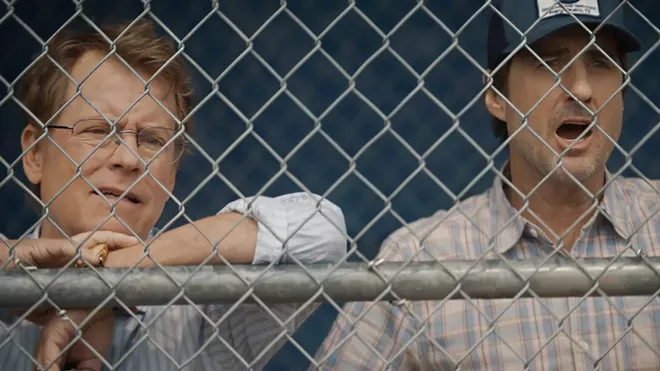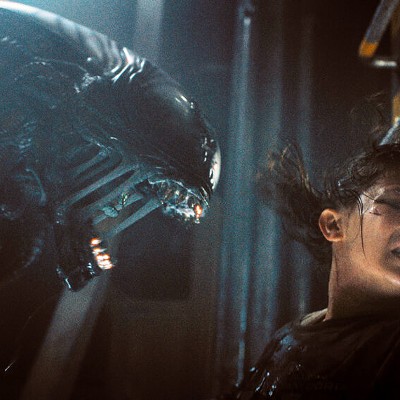Slingshot’s journey an unexpected trip inwards
The seed is planted early in Mikael Hafstrom’s Slingshot that
something is amiss. We’re made to know that the side effects from the drugs
used on the astronauts in question can be severe, hallucinations being at the
top of the list. R. Scott Adams and Nathan Parker’s script exploits this notion
to create a pervasive sense of paranoia that has the viewer questioning every
situation presented. It’s an approach
that could easily backfire, as similar projects have fallen victim to the
screenwriters being a bit too clever for their own good.
For the most part, Slingshot works, as this intimate
sci-fi exercise, reminiscent of Solaris and Moon, deals more with
inner space than outer, the galaxy of the characters’ minds the environment
being explored. As such, the turns in the story are many, keeping the viewer on
their toes as we can’t help but question, like the trio of astronauts in
question, just what is real and what isn’t.
The time is the near future and the mission undertaken by
the Odyssey 1 is a journey to Titan, the largest moon orbiting Saturn. It
happens to have an atmosphere most resembling that of Earth, which is reeling
from the effects of global warming. The
hope is to harvest (?) or study the massive amounts of methane it contains in
order to utilize the gas to help stabilize our environment.
Obviously, this is not a quick run around the block to pick
up a quart of milk. The journey will take nearly two years, requiring the
astronauts – John (Casey Affleck), Nash (Tomer Capone) and Captain Franks
(Laurence Fishburne) - chosen for this assignment to be in cryogenic chambers
for most of the trip. However, they are awakened every 90 days to check on
the ship and instruments to make sure all is in ship shape. The drugs they are
given to send them to the land of nod are, perhaps, too effective.
Of course, problems develop as Nash is afflicted with a deep
sense of paranoia and fear, which is exacerbated when the ship is damaged and
the computer systems start to glitch. Convinced they are going to die, he
proposes they turn the ship around, something John initially opposes. However,
once they all awaken from another sleep cycle he, too, begins to question the
ship’s stability and eventually that of his own mind. After all, how else can the appearance of Zoe
(Emily Beecham), the woman he left behind, in the hallways of the ship be
explained? And why is he hearing voices from Earth on radios that only pick up
signals from a few miles away?
The side effects are obviously to blame, but the game
becomes determining what is real and what isn’t. Obviously, Zoe’s repeated appearances are
illusions but the damage to the ship and the “problems” that result from it remain in question. Can we believe what John and Nash see? And just why isn’t
Franks suffering from any of these delusions?
As we witness the struggle between these three develop,
these scenes are intertwined with flashbacks involving Zoe and John. Their
meeting, courtship and breakup are all revealed during key moments of his
unraveling. As such, their validity is also ultimately called into question,
adding to the uncertainty of John’s mental state.
Barry Chusid’s production design proves both inviting and
menacing. Suffused in tones of cool white and teal, there’s a soothing nature
to the environment, one that deceptively encourages submission. That we only
see a very few spaces on the ship stokes a sense of claustrophobia that
increases as the film progresses, while its one, circular hallway subtly
suggests the inescapable nature of John’s paranoia.
The film flirts with overstaying its welcome, some scenes
running a bit long, a confrontation or two unnecessary. However, the questions at the center of the
story keep us engaged, the fine performances by all adding to the urgency of
the premise.
The answer to the problems that plague John are narratively
sound, as no out-of-left-field tricks are employed during the third act.
Ultimately, Slingshot poses uncomfortably personal questions regarding
memory and identity, serving as an effective metaphor for the psychological
troubles many of us contend with. It offers little in the way of solutions
where mental health is concerned, its suggestion of staying true to yourself ultimately proving faulty, at least in this instance. In theaters.
Believe is woefully sincere
Taking place in Fort Worth in 2002, Ty Roberts’ You Gotta Believe focuses on the Westside Little League team, who are the Bad News Bears made real. Unable to field a ball, get a hit or throw to the right base, they are incompetence personified. Their two coaches – lifelong friends Bobby Ratliff and Jon Kelly (Luke Wilson and Greg Kinnear) – take different approaches to their job. The former is passionate, the latter indifferent.
However, that all changes when a desperate official for the
league approaches them about entering their team in the National Little League
World Series Tournament. Reluctant to do so, Kelly decides to take on this task
when Ratliff is diagnosed with cancer. Knowing that seeing his boys play ball
will be the best medicine for him, the coach decides to whip the kids into
shape and hopefully inspire his friend along the way.
According to the press notes, the Westside All-Stars
advanced deep into the tournament, and the story concerning Ratliff was picked
up by ESPN, leading it to be covered nationally.
Archival footage of Ratliff and his players shown during the end credits
confirm this. I’m sure that it was a genuinely moving story.
I wish I could say the same regarding Believe. While
its intent is admirable, it’s execution is woeful. While I don’t expect
subtlety from faith-based movies like this, I resent the sentiment being laid
on with a trowel. A deft touch goes much further towards moving an audience
rather than hammering them over the head with a series of melodramatic moments
underscored by a treacly score. This is exemplified most shamefully during the
closing credits when one of the now-grown players engages in a staged, “heartwarming”
scene with his own son. You’ll be excused if your eyes roll during this cloying
sequence.
Wilson, Kinnear, Sarah Gadon and Molly Parker, capable
performers all, do what they can to ground the film and manage to inject a bit
of sincerity here and there. Yet, when working with a script that favors the
obvious over cleverness, it proves to be a losing battle. In the end, by
swinging for the fences emotionally, Believe ends up striking out. Available
through Video-On-Demand.




















